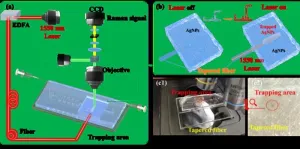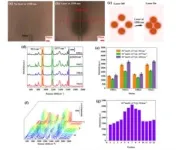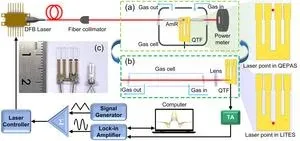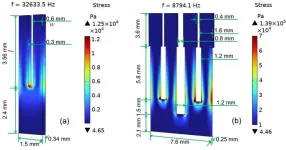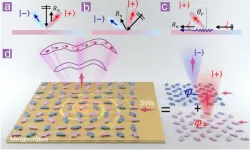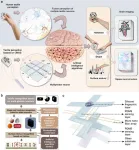A new publication from Opto-Electronic Advances; DOI 10.29026/oea.2025.240182 , discusses a single-beam optical trap-based surface-enhanced Raman scattering optofluidic molecular fingerprint spectroscopy detection system.
Raman spectroscopy is a non-destructive analytical technique that allows for precise analysis of substances based on their unique molecular Raman spectral characteristics. However, traditional Raman spectroscopy techniques suffer from weak signal intensity, limiting their sensitivity in high-sensitivity detection applications. Surface-enhanced Raman scattering (SERS) technology, on the other hand, can amplify Raman signals by several million times. The optofluidic SERS system, which integrates SERS technology with lab-on-a-chip systems, enables precise control of fluid motion on a microscale and execution of complex experimental procedures. This results in rapid, portable, and efficient on-site analysis, which is highly valuable for fields such as environmental monitoring, medical diagnostics, and food safety. Especially for scenarios requiring immediate on-site testing, such as pathogen screening during an infectious disease outbreak or pollutant detection in environmental pollution incidents, this integrated technology offers significant convenience and timeliness.
Currently, chips used for optofluidic SERS detection face several challenges, including maintaining stable enhancement effects over long periods and achieving timed and targeted detection. Employing optical tweezers technology to capture and aggregate metal nanoparticles can increase local electromagnetic field strength and improve signal uniformity. Integrating SERS technology, optical tweezers, and optofluidics on a chip to achieve a controllable mechanism for amplifying molecular fingerprint spectra is crucial for the development of trace molecule Raman detection systems.
The authors of this article reported a surface-enhanced Raman scattering (SERS) optofluidic molecular fingerprint spectroscopy detection system based on a single-beam optical trap. This system uses a single-beam optical trap to aggregate free silver nanoparticles (AgNPs) within an optofluidic chip, thereby enhancing the SERS performance of molecules and achieving a controllable mechanism for amplifying molecular fingerprints.
In this setup, a single-mode fiber is used to couple a 1550 nm laser into the SERS detection area of the optofluidic chip, creating a gradient optical field near the tapered fiber tip. The free AgNPs located in this gradient optical field are drawn towards the vicinity of the tapered fiber due to the force exerted by the optical field. As the AgNPs accumulate, the inter-particle distance significantly decreases. When 532 nm excitation light irradiates the aggregated region, localized "hot spots" form, intensifying the Raman scattering signals of the target molecules in that area, thus enabling highly sensitive molecular fingerprint detection. For Raman detection, users can directly examine the region near the tapered fiber tip within the detection chamber of the optofluidic chip. The core innovation of this study lies in developing a stable and controllable SERS detection platform optimized for two application scenarios. Firstly, under laboratory conditions, the platform provides a stable, reliable, and highly sensitive environment for the Raman detection of liquid samples. Moreover, the system can be integrated with a portable Raman spectrometer to create a portable SERS detection system equipped with an integrated portable Raman detection unit. The entire system can be conveniently installed in a laboratory toolkit or mobile device, allowing users to independently complete liquid SERS detection tasks after brief training. By integrating SERS, optical trapping, and microfluidic chip technologies, this research offers a positioning and timing-controlled, highly sensitive, and portable molecular fingerprint detection platform. This innovative approach not only addresses some of the challenges faced by current SERS-based detection chips, such as maintaining stable enhancement effects over time and achieving timed and targeted detection but also expands the practical applications of SERS technology in various fields, including environmental monitoring, medical diagnostics, and food safety.
Keywords: surface-enhanced Raman scattering / optofluidic / single-beam optical trap / tapered optical fibers
# # # # # #
Professor Jie Zhang, a doctoral supervisor, has focused in recent years on the research of new Raman spectroscopy instruments and surface-enhanced Raman spectroscopy using nanomaterials. Currently, she serves as a standing committee member of the Photoelectric Technology Professional Committee of the Optical Society, a committee member of the Spectroscopy Technology and Application Professional Committee of the Optical Engineering Society, a committee member of the Light Scattering Professional Committee, and an editorial board member of the "Journal of Light Scattering". She has led five National Natural Science Foundation projects, special innovation projects in defense zones, and others. Professor Zhang was awarded the Second Prize for Technical Invention by Chongqing Municipality and has transferred three patents.
The authors of this paper all come from the "Optical Micro/Nano Devices and Systems" team at the School of Optoelectronic Engineering, Chongqing University. The team comprises over 30 members, including three professors. In recent years, the team has systematically conducted application foundational research in optical fiber sensors suitable for use under extremely harsh conditions and high-precision measurement instruments based on spectroscopy detection technology. The precision testing instruments developed by the team have been applied in several national major projects, highlighting their contributions to advancing technical capabilities in these areas.
# # # # # #
Opto-Electronic Advances (OEA) is a rapidly growing high-impact, open access, peer reviewed monthly SCI journal with an impact factor of 15.3 (Journal Citation Reports for IF2023). Since its launch in March 2018, OEA has been indexed in SCI, EI, DOAJ, Scopus, CA and ICI databases over the time, and expanded its Editorial Board to 34 members from 17 countries.
# # # # # #
More information: http://www.oejournal.org/oea
Editorial Board: http://www.oejournal.org/oea/editorialboard/list
All issues available in the online archive (http://www.oejournal.org/oea/archive).
Submissions to OEA may be made using ScholarOne (https://mc03.manuscriptcentral.com/oea).
ISSN: 2096-4579
CN: 51-1781/TN
Contact Us: oea@ioe.ac.cn
Twitter: @OptoElectronAdv (https://twitter.com/OptoElectronAdv?lang=en)
WeChat: OE_Journal
# # # # # #
Sun N, Gan Y, Wu YJ et al. Single-beam optical trap-based surface-enhanced raman scattering optofluidic molecular fingerprint spectroscopy detection system. Opto-Electron Adv 8, 240182 (2025). doi: 10.29026/oea.2025.240182
END
